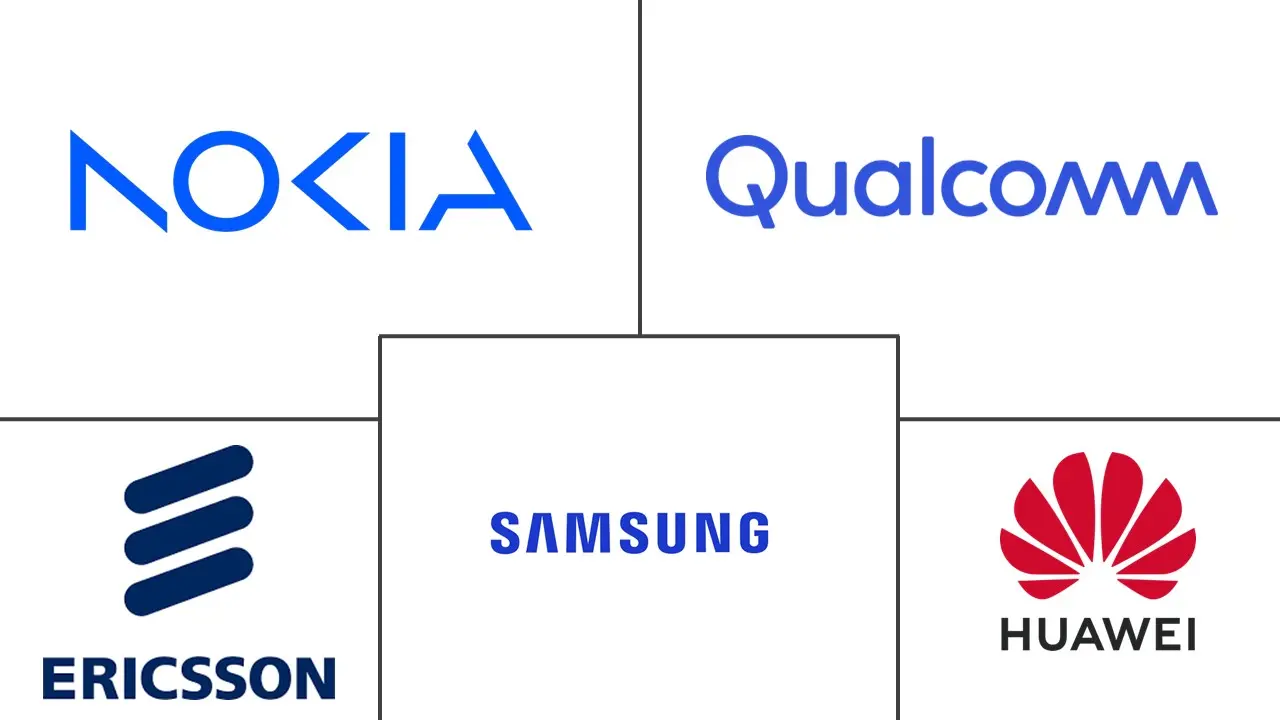Fixed Wireless Access Market Size and Share
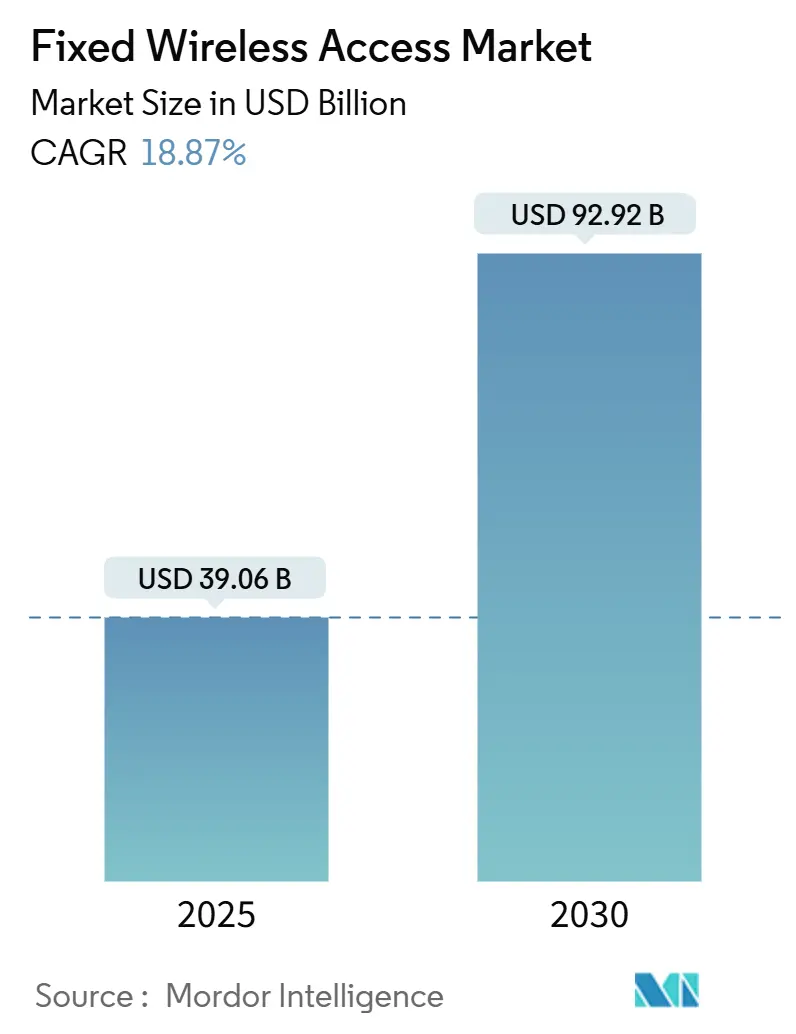
Fixed Wireless Access Market Analysis by Mordor Intelligence
The fixed wireless access market is valued at USD 39.06 billion in 2025 and is forecast to reach USD 92.72 billion by 2030, reflecting an 18.87% CAGR and confirming the fixed wireless access market size as one of the most rapidly expanding broadband segments[1]Ericsson, “Fixed Wireless Access – Ericsson Mobility Report,” ericsson.com . Expansion rests on three pillars: accelerated 5G roll-outs that repurpose existing mobile towers for home broadband, growing demand for affordable last-mile connectivity in rural districts, and continuous innovation in customer-premises equipment that delivers near-fiber speeds. Operators in North America and Asia Pacific have redirected capital from traditional fiber-to-the-home toward fixed wireless, trimming deployment timelines and reducing per-household costs by wide margins. Spectrum allocations in Sub-6 GHz, coupled with millimeter-wave launches in dense urban zones, give providers the flexibility to balance coverage and capacity. Meanwhile, industrial IoT pilots are turning fixed wireless access links into secure, low-latency backbones for factories and logistics hubs, thereby opening fresh revenue streams.
Key Report Takeaways
- By type, hardware captured 65% of the fixed wireless access market share in 2024; services are set to grow at a 19.60% CAGR through 2030.
- By application, residential use accounted for 52% of the fixed wireless access market size in 2024; industrial applications are tracking a 22.32% CAGR to 2030.
- By frequency band, the Sub-6 GHz tier led with 60% revenue in 2024, whereas the mmWave tier is expected to accelerate at a 23.27% CAGR.
- By deployment mode, outdoor CPE represented 56% of shipments in 2024 and is forecast to expand at an 18.69% CAGR.
- By geography, Asia Pacific held 37% of the fixed wireless access market share in 2024 while recording the fastest projected CAGR of 21.07% for 2025-2030.
Global Fixed Wireless Access Market Trends and Insights
Drivers Impact Analysis
| Driver | ( ~ ) % Impact on CAGR Forecast | Geographic Relevance | Impact Timeline |
|---|---|---|---|
| 5 G roll-out accelerating gigabit-class FWA | +5.2% | Global with concentration in North America, Europe, developed APAC | Medium term (2-4 years) |
| Rural broadband stimulus programmes | +4.8% | North America, Europe, India, emerging APAC | Long term (≥ 4 years) |
| FWA as cost-effective last-mile alternative to fibre | +3.7% | Global, stronger pull in developing regions | Medium term (2-4 years) |
| Enterprise SD-WAN back-up connectivity demand | +2.1% | North America, Europe, developed APAC | Short term (≤ 2 years) |
| Source: Mordor Intelligence | |||
5G Roll-out Accelerating Gigabit-class FWA
Widespread 5G deployment allows operators to layer fixed wireless access on the same radio network, turning mobile macro sites into neighborhood broadband nodes. U.S. carriers report the majority of net broadband additions coming from fixed wireless packages, underscoring how the fixed wireless access market is eating into cable’s traditional base. Investments in massive MIMO and beamforming raise outdoor CPE throughput while sustaining service in non-line-of-sight environments. Ericsson software upgrades extend usable range without new hardware, simplifying rural coverage. Vendors such as Nokia have showcased mmWave receivers that hold a 1 Gbps link at distances up to 7 km, proving viability in both dense cities and sparsely populated fringes. Taken together, these advances lift customer experience to fiber-like benchmarks and boost adoption across homes and enterprises.
Rural Broadband Stimulus Programmes
Public funding is narrowing digital divides by underwriting radio access equipment and CPE for towns bypassed by fiber trenching. In the United States, federal and state grants funnel billions into unserved census blocks, and fixed wireless access often receives priority because towers are deployed in weeks rather than months. Washington State regulators confirm that FWA solutions can be installed rapidly at lower cost, albeit with modest speed trade-offs compared with fiber. Europe’s Digital Decade agenda mirrors this approach through flexible spectrum rules that invite wireless internet service providers into rural bands. Cost-benefit studies from The Brattle Group link broadband expansion, including fixed wireless, to trillions in property-value and income gains, fueling more policy support[2]Fiber Broadband Association, “Fiber Deployment Annual Report 2023,” fiberbroadband.org .
FWA as Cost-effective Last-mile Alternative to Fibre
Next-generation fixed wireless cuts life-cycle spending to one-third of an all-fiber build, according to Tarana Wireless field modelling[3]Tarana Wireless, “ngFWA vs Fiber,” taranawireless.com . Labor drives over two-thirds of fiber cost, and aerial installations still exceed USD 6 per ft on average. In comparison, a single rooftop radio and self-install indoor CPE can light up hundreds of homes. Operators redirect saved capital to marketing and service upgrades, accelerating subscriber uptake. The economics resonate strongly in suburban belts where trenching rights-of-way remain expensive yet data demand looks identical to urban centers.
Enterprise SD-WAN Back-up Connectivity Demand
Corporate IT teams view fixed wireless links as a fast insurance against fiber outages. Blue Wireless packages include rugged CPE, unlimited data, and 24-hour installation windows[4]Blue Wireless, “Fixed Wireless Access For Business,” bluewireless.com. Integration with software-defined WAN keeps application traffic on priority paths and triggers automatic failover when the main circuit drops. Managed-service providers such as Wireless Logic layer 5 G capacity with satellite for diverse routing in energy, retail, and utilities sectors. Network slicing in 5 G cores enables service-level enforcement so that backup circuits still meet latency and jitter targets for payments or telemedicine. This business-continuity use case lifts average revenue per account and positions the fixed wireless access market as a staple of enterprise networks
Restraints Impact Analysis
| Restraint | ( ~ ) % Impact on CAGR Forecast | Geographic Relevance | Impact Timeline |
|---|---|---|---|
| Spectrum scarcity & regulatory uncertainty | –2.3% | Global, higher pressure in mature markets | Medium term (2-4 years) |
| High mmWave densification CAPEX | –1.8% | Urban centers in North America, Europe, developed APAC | Short term (≤ 2 years) |
| Source: Mordor Intelligence | |||
Spectrum Scarcity & Regulatory Uncertainty
Mid-band spectrum sits at the sweet spot between coverage and capacity, yet much of it is tied up in legacy use or contested by incumbent broadcasters. Lobbying battles over the lower 3 GHz block in the U.S. illustrate how protracted policymaking can stall operator investment. Dynamic sharing systems such as Google’s Spectrum Access System allow opportunistic use, but device ecosystems still rely on clear, licensed holdings. Varied regional rules complicate global equipment design, raising costs and slowing volume manufacturing. Although national road maps, including the NTIA National Spectrum Strategy, promise additional allocations, uncertainty lingers through auction delays and shifting priorities.
High mmWave Densification CAPEX
Millimeter-wave radios execute multi-gigabit bursts but propagate poorly through walls or foliage. Urban coverage therefore depends on a dense web of small cells, with profitability hinging on household density. Qorvo modelling shows that the business case turns positive only above 1000 premises per sq km. Outdoor CPE mitigates some obstacles yet requires professional installation that adds cost. New beamforming chipsets push energy efficiency forward, and through-window CPE variants cut installation times, but capital intensity remains a hurdle in early years. Operators often start with Sub-6 GHz for blanket coverage and introduce mmWave only in peak-traffic corridors to balance spend and service quality.
Segment Analysis
By Type: Services Outpace Hardware Growth
Hardware retained a 65% share of the fixed wireless access market in 2024 thanks to intensive early-stage spending on radios and CPE that anchor network roll-outs. Indoor devices make up 60% of units shipped, while outdoor models dominate revenue because of higher unit pricing and professional installation. Operators and vendors continue to innovate on thermals, antenna gains, and router software, giving customers a self-install experience that parallels Wi-Fi mesh kits. The fixed wireless access market size attributable to hardware is projected to expand, yet at a slower clip than subscriptions.
The services segment is set for a 19.60% CAGR through 2030, outstripping the rest of the fixed wireless access industry as providers diversify into managed Wi-Fi, over-the-top video, and cloud security bundles. More than 40% of operators have migrated to speed-based tariff menus that mimic fiber grade tiers, accelerating average revenue per user. Network APIs will soon enable on-demand throughput boosts during live events or e-sports tournaments, further lifting service margins. As adoption reaches scale, recurring fees rather than equipment sales will define earnings power.
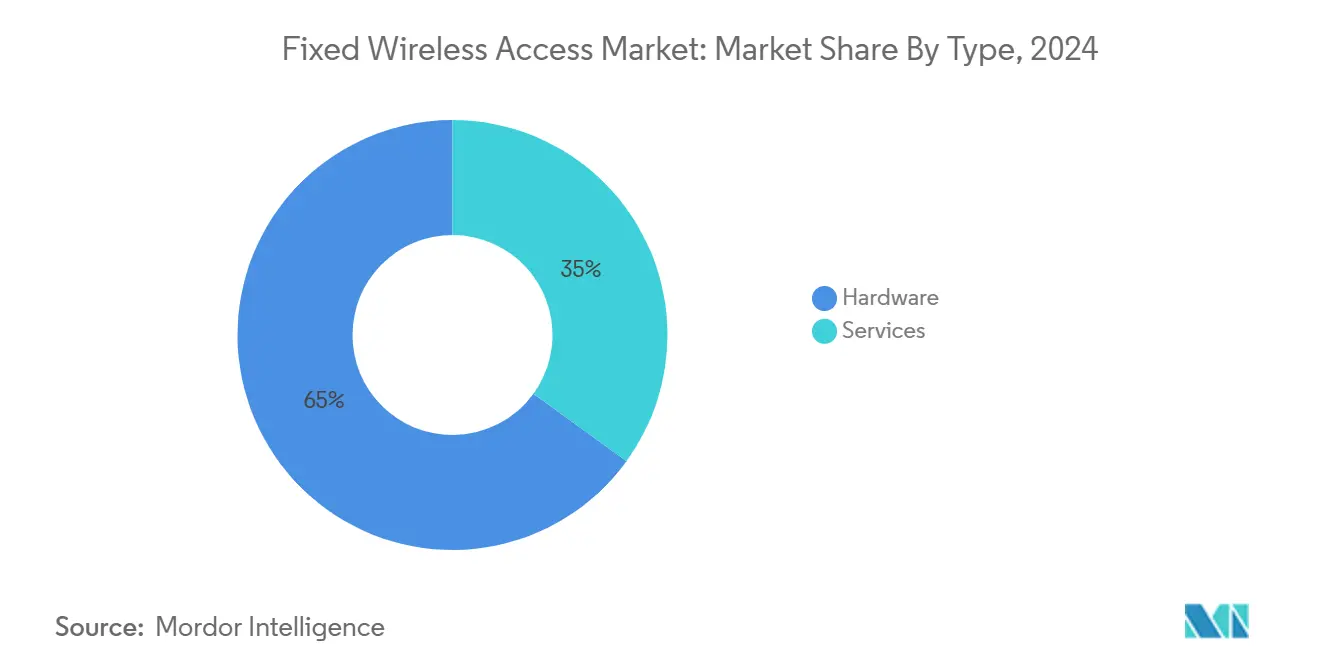
By Application: Industrial Sector Drives Innovation
Residential broadband accounted for 52% of overall revenue in 2024, reflecting aggressive consumer campaigns by Tier-1 mobile carriers. Promotions often bundle streaming subscriptions and zero-cost hardware, which compresses churn. Industrial deployments, in contrast, record a 22.32% CAGR to 2030. Factories insert fixed wireless gateways between production lines and edge servers, supporting real-time machine vision, robotics, and safety systems. Trials have demonstrated a median downlink of 648 Mbps and peaks above 1 Gbps using carrier-aggregated spectrum[5]Fibocom, “5 G FWA Solution – IoT Application Scenarios,” fibocom.com. These metrics satisfy stringent availability targets common in automotive and semiconductor plants.
Commercial sites such as quick-service restaurants rely on fast turn-ups and flexible contracts to connect point-of-sale systems and digital signage. Education and healthcare settings also favor rapid deployment over trenching permits. Consequently, fixed wireless access market players tailor vertical packages that integrate private 5 G cores with zero-touch provisioning.
By Frequency Band: mmWave Leads Growth Trajectory
Sub-6 GHz deliveries covered 60% of the fixed wireless access market share in 2024 because a single macro site can illuminate wide rural tracts. This band uses existing LTE and 5 G allocations, enabling operators to re-farm spectrum without new licenses. Coverage first, capacity second, remains the mantra for low-density populations. However, consumer demand in dense suburbs soon stresses cell-edge speeds, prompting mixed-band overlays.
The mmWave tier is forecast to grow at 23.27% CAGR through 2030. Nokia, ZTE, and Ericsson have recorded field speeds above 3 Gbps and low-latency links ideal for cloud gaming zte.com.cn. Larger contiguous blocks simplify channel aggregation and future-proof networks for 8 K video and holographic collaboration. Although propagation challenges persist, 360-degree antenna arrays and auto-alignment software compress installation time. As component prices fall, receivers are moving from rooftops to windowsills, increasing addressable households without extra truck rolls.
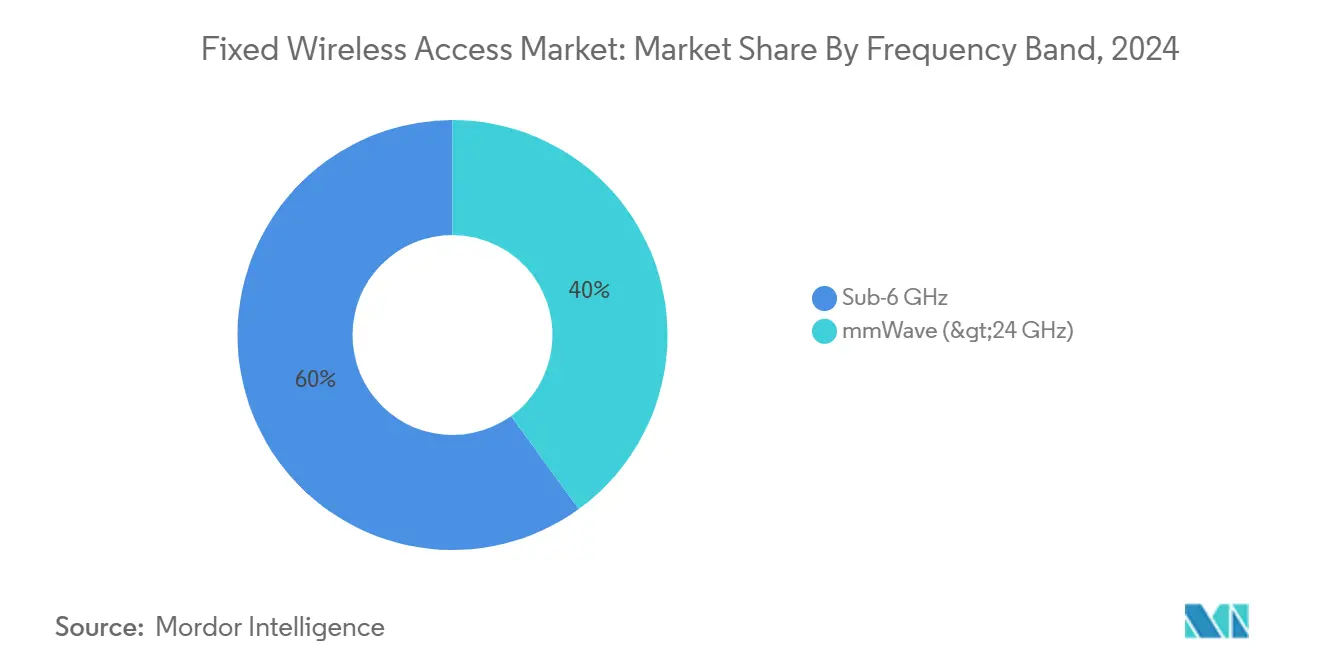
By Deployment Mode: Outdoor CPE Maintains Dual Leadership
Outdoor CPE represented 56% of unit shipments and also leads growth at an 18.69% CAGR, reflecting its superior radio performance. Elevated placement avoids obstructions, boosting fade margins and sustaining gigabit links even in rain fade scenarios. Operators often absorb installation costs in high-ARPU zones because performance gains translate directly into retention and upsell opportunities. The fixed wireless access market size for outdoor devices should keep pace with demand for ultra-high-definition streaming.
Indoor routers still dominate install counts because renters and small offices prefer self-service setups. However, penetration of low-E glass and thicker insulation in newer buildings has nudged vendors to launch through-window CPE that slides between categories. Flexi CPE with detachable antennas allows providers to switch modes without hardware swaps, cutting truck rolls and inventory risk. This adaptability dovetails with dynamic network planning, where spectrum resources shift between home and mobile users based on traffic peaks.
Geography Analysis
Asia Pacific keeps a 37% revenue share and posts the fastest 21.07% CAGR as 5 G population coverage exceeds 85% in China, South Korea, and Japan. India’s top two operators have bundled AirFiber services with pay-per-day vouchers, capturing millions of first-time broadband users in less than a year. Government incentives under Digital India reimburse up to 80% of tower equipment in unserved villages, further accelerating roll-out. Fixed wireless access market players also benefit from device-manufacturing hubs across the region that shorten supply chains.
North America follows, fueled by large-scale 5 G standalone cores and supportive spectrum policy. The fixed wireless access market size in the United States is climbing as telecoms redeploy mid-band holdings cleared from satellite services. Operators routinely report 600,000 to 700,000 net additions per quarter, a trend that has forced cable incumbents to introduce symmetrical tiers. Canada’s rural broadband drive funds rooftop radios for farms and tourist lodges where fiber trenching through permafrost is impractical.
Europe shows a fragmented pattern. Northern nations with high fiber coverage use fixed wireless mainly for redundancy, while Southern and Eastern countries leverage it to leapfrog copper upgrades. Regulatory flexibility in the 26 GHz band encourages cross-border equipment harmonization, which lowers CPE cost. Emerging markets in the Middle East and Africa rely on wireless first solutions for last-mile access. National broadband plans treat fixed wireless as the primary method to connect schools and clinics within two years, positioning the fixed wireless access market as a catalyst for digital inclusion across the continent.
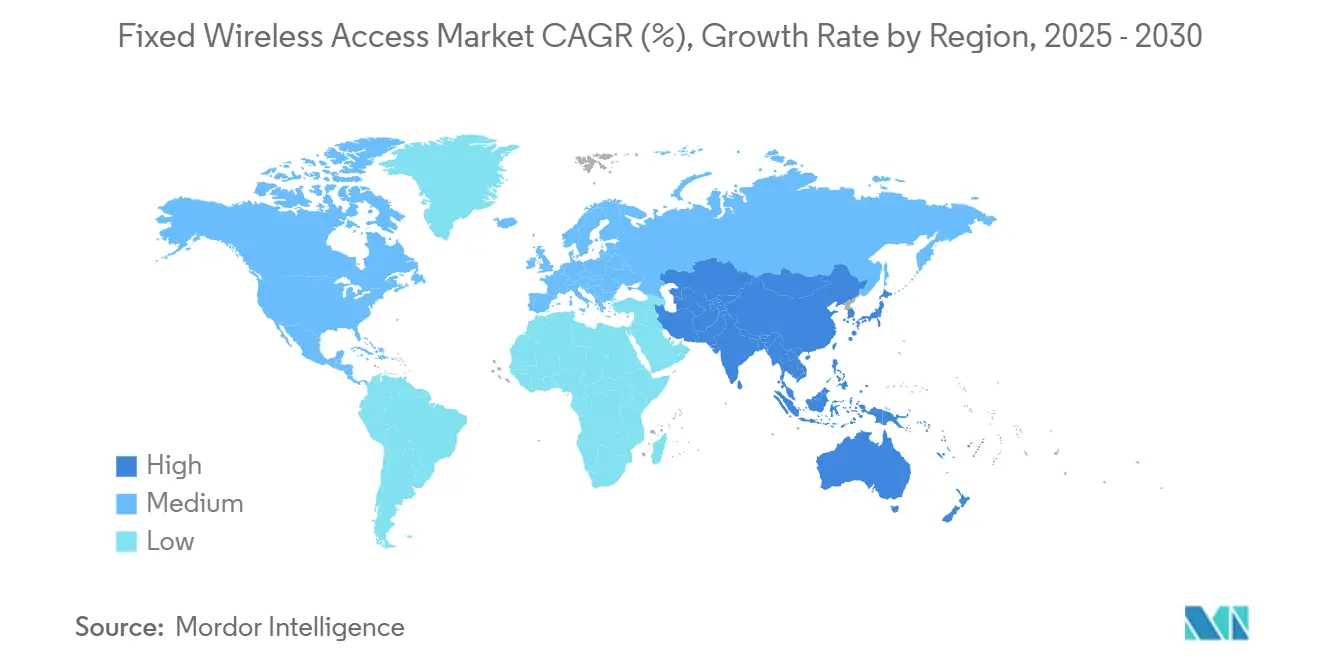
Competitive Landscape
Equipment vendors dominate the infrastructure layer through continual silicon and antenna upgrades. Huawei, Nokia, Ericsson, Samsung, and ZTE supply radios, CPE, and integrated cores that underpin most commercial launches. Nokia cites FWA as a pillar of its technology-leadership strategy despite macroeconomic headwinds that trimmed 2024 network-infrastructure sales. Component specialists such as Qorvo and Qualcomm push down chipset costs while raising thermal efficiency, reinforcing vendor roadmaps.
Service-provider rivalry is robust. Mobile network operators exploit existing tower footprints and brand recognition to cross-sell fixed wireless to smartphone subscribers. Cable firms counter with hybrid fiber-coax promotions and speed upgrades. Wireless internet service providers in rural belts focus on customer intimacy and localized support. Strategic partnerships are central: Cisco collaborates with carriers to integrate mobility services platforms that secure enterprise traffic end-to-end cisco.com. Blue Wireless and Wireless Logic tailor turnkey packages for multinational firms that require consistent SLAs across dozens of countries.
Satellite operators enter the arena through hybrid bundles that blend low-earth-orbit capacity with terrestrial 5G; this extends reach without sacrificing latency-sensitive workloads. Industry observers expect consolidation as spectrum auctions and CPE subsidies favor scale players. The fixed wireless access market currently reflects moderate concentration, yet local license rules preserve niches for municipal and cooperative ISPs, especially in agriculture and mining corridors.
Fixed Wireless Access Industry Leaders
-
Huawei Technologies Co. Ltd.
-
Nokia Corporation
-
Ericsson AB
-
Qualcomm Technologies Inc.
-
Samsung Electronics Co. Ltd.
- *Disclaimer: Major Players sorted in no particular order
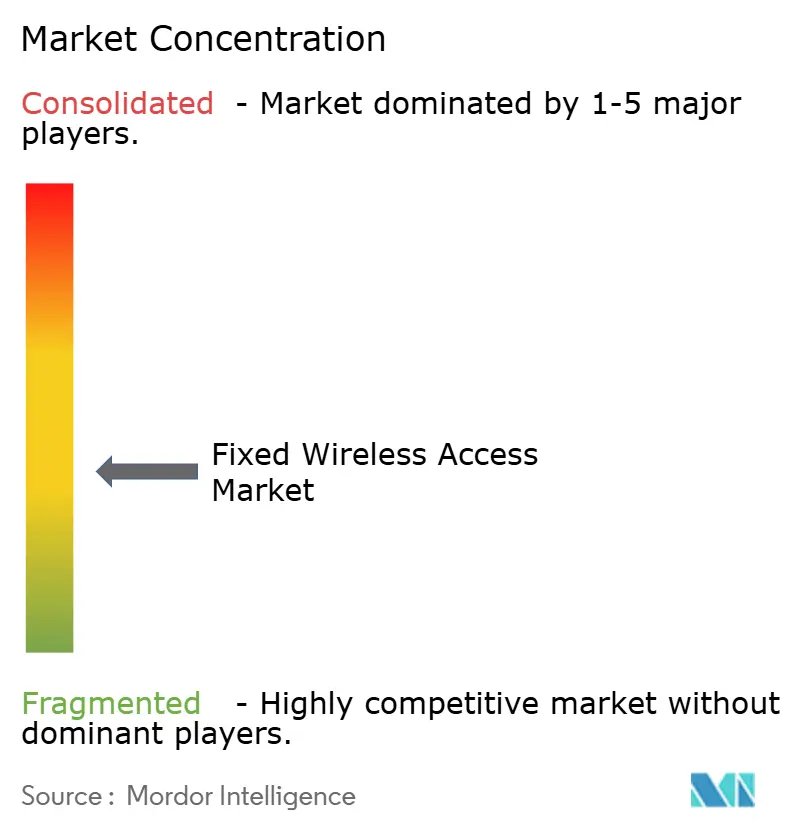
Recent Industry Developments
- February 2025: Ericsson unveiled the X20, a purpose-built FWA platform for small businesses that allows mobile operators to reach enterprise customers without trenching.
- January 2025: AT&T added 324 000 postpaid wireless and 181 000 fixed wireless access subscribers in Q1 2025 as part of its multi-year broadband expansion strategy.
- September 2024: T-Mobile secured a ‘BBB+’ Fitch rating on new unsecured notes, with fixed wireless access momentum cited as a key growth pillar.
- July 2024: Wireless Logic introduced managed 5 G and Starlink-backed FWA packages for energy, education, and utility clients.
Research Methodology Framework and Report Scope
Market Definitions and Key Coverage
Our study considers the fixed wireless access (FWA) market as all revenue earned from devices and services that deliver last-mile broadband using licensed or lightly licensed cellular spectrum, primarily 4G LTE and 5G, to a static customer premises equipment (CPE) that then distributes Wi-Fi or Ethernet within homes and businesses. The model tracks hardware shipments, managed service fees, and related subscription revenues in every major region.
Scope exclusion: Satellite or unlicensed Wi-Fi backhaul solutions are not included.
Segmentation Overview
- By Type
- Hardware
- Consumer Premise Equipment (CPE)
- Access Units (Femto and Picocells)
- Services
- Hardware
- By Application
- Residential
- Commercial
- Industrial
- By Frequency Band
- Sub-6 GHz
- mmWave ( above 24 GHz)
- By Deployment Mode
- Indoor CPE
- Outdoor CPE
- By Geography
- North America
- South America
- Europe
- Asia-Pacific
- Middle East and Africa
Detailed Research Methodology and Data Validation
Primary Research
To ground the numbers, our team held structured calls with network planners at top mobile operators, senior engineers at CPE vendors, and regulators overseeing universal-service programs across North America, Europe, Asia Pacific, the Gulf states, and Latin America. Insights on 5G deployment timelines, subsidy uptake, and outdoor CPE pricing fed directly into the model and reconciled any mismatches spotted during desk analysis.
Desk Research
We first mined open-source benchmarks from respected bodies such as the International Telecommunication Union, the FCC, the European 5G Observatory, GSMA Intelligence, Ericsson Mobility Report, and national statistics portals, which supply subscriber counts, spectrum allocations, and rural broadband targets. Company filings, investor decks, and large-carrier tariff sheets added typical average revenue per user. Paid intelligence sets that Mordor analysts access, including D&B Hoovers for operator financials and Dow Jones Factiva for deal flow, helped cross-check growth hotspots. The sources named illustrate our desk research foundation; many additional references were reviewed for data points, context, and gap confirmation.
Market-Sizing & Forecasting
Mordor Intelligence applied a top-down build that aligns national household and business counts with broadband penetration targets, spectrum roll-outs, and government funding pools, which are then translated into potential FWA subscriptions. Selected bottom-up checks, carrier reported subscriber adds, sampled CPE average selling prices, and tower lease data validated totals and flagged over-inflated pockets. Key variables include 5G base-station growth, CPE shipment forecasts, spectrum auction schedules, rural broadband subsidies, typical ARPU shifts, and fiber passings per capita. An error-corrected multivariate regression, informed by primary expert consensus, projects each driver through the forecast period and produces the growth rate that underpins our baseline.
Data Validation & Update Cycle
Outputs undergo variance scans versus independent traffic, device, and capex trackers before a senior reviewer sign-off. Reports refresh every twelve months, with interim updates triggered by spectrum policy changes, major subsidy awards, or step-shifts in carrier guidance. Just before delivery, an analyst re-runs the checks so clients receive the latest view.
Why Mordor's Fixed Wireless Access Market Baseline Earns Trust
Published estimates rarely match because firms diverge on what revenue streams, CPE classes, and forecast windows they include.
Key gap drivers are scope creep into satellite broadband, reliance on aggressive CPE price deflation curves, conversion of connection counts to revenue without validating ARPU, and infrequent refresh cycles that ignore fast-moving 5G deployments.
Benchmark comparison
| Market Size | Anonymized source | Primary gap driver |
|---|---|---|
| USD 39.06 B (2025) | Mordor Intelligence | - |
| USD 161.27 B (2024) | Global Consultancy A | Combines FWA with all cellular backhaul and includes satellite links |
| USD 36.54 B (2024) | Industry Publisher B | Uses limited operator sample and flat ARPU, undercounts emerging Asia volumes |
| USD 145.34 B (2024) | Trade Journal C | Applies single global ASP and projects revenue directly from device shipments |
The comparison shows that once inconsistent scopes and unchecked assumptions are stripped away, Mordor's disciplined mix of verified variables, frequent updates, and dual-layer validation yields a balanced baseline practitioners can reproduce and trust for strategic planning.
Key Questions Answered in the Report
What is the current Fixed Wireless Access Market size?
The Fixed Wireless Access Market is projected to register a CAGR of 10.17% during the forecast period (2025-2030)
What is the current size of the fixed wireless access market?
The market stands at USD 39.06 billion in 2025 and is forecast to reach USD 92.72 billion by 2030.
How fast is the fixed wireless access market growing?
It is expanding at an 18.87% CAGR, making it one of the fastest-growing broadband delivery methods.
Which region leads global adoption?
Asia Pacific holds 37% of revenue and shows the highest projected CAGR of 21.07% between 2025 and 2030.
Why are operators choosing fixed wireless over fiber?
Fixed wireless costs about one-third of an all-fiber build over the life cycle and deploys in weeks, not months, making it attractive for underserved areas.
What role does 5 G play in fixed wireless success?
5G provides the capacity and low latency needed for gigabit-class service, enabling operators to reuse macro sites for broadband and widen coverage rapidly.
How are enterprises using fixed wireless access?
Companies integrate it into SD-WAN frameworks as either primary or backup links, ensuring network resilience and quick deployment across distributed sites.
Page last updated on:
